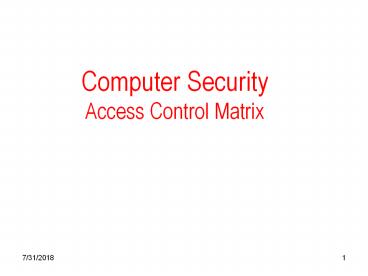Computer%20Security%20Access%20Control%20Matrix - PowerPoint PPT Presentation
Title:
Computer%20Security%20Access%20Control%20Matrix
Description:
Copying and owning. Rights. copy right (grant right) augments existing rights. own right. The copy right allows its possessor to grant rights (this right is ... – PowerPoint PPT presentation
Number of Views:97
Avg rating:3.0/5.0
Title: Computer%20Security%20Access%20Control%20Matrix
1
Computer SecurityAccess Control Matrix
2
States of a Computer System
- The state of a system is the collection of
current values of all - components of the system memory locations,
secondary - storage, registers etc.
- Protection states are those states that have to
be protected. - .P set of all protection states of the system
- .Q set of all authorized protection states
- The system is not secure if the current state is
in P -Q - A security policy characterizes the states in Q
- A security mechanism prevents the system entering
- a state in P -Q
3
Access Control Matrix Model
- This is used to describe the protection states.
- It characterizes the rights of each subject of
the - system (entity/process) regarding the objects of
the - system (entities/processes) in terms of a matrix.
4
Butler-Lampson Model
- This describes the rights of users s (subjects)
over - files o (objects) by a matrix A whose rows are
indexed - by the subjects and whose columns are indexed by
- the objects.
- The rights belong to a set R.
- Each entry as,o of matrix A belongs to the set
R, and - is the right of user s over file o.
5
Butler-Lampson Model
- In this model set of protection states P is a
set of - triples in (S,O,A),
- where S is the set of users, O the set of files
and A the - Access Control Matrix.
- The set of rights R (the entries in M) depends on
the - application.
6
Examples of ACMs
- file 1 file 2
process 1 process 2 - process 1 R, W, O R R,
W, E, O W - process 2 A R, O
R R, W, E, O - Here R Read, Wright, Own, Append, Execute
- process 1 can read/write file 1, read file 2,
communicate - with process 2 by writing to it, etc.
7
Examples rights on a LAN
- host names telegraph nob
toadflex - telegraph own ftp
ftp - nob ftp,
nfs, amil own ftp, nfs, mail
- toadflex ftp,
mail ftp, nfs, amil own - Here R ftp, mail, nfs, own , where
- ftp the right to access the File Transfer
Protocol - mail the right to send/receive using the Simple
Mail Transfer Protocol (SMTP) - nfs the right to access file systems using the
Network File System protocol
8
Examples rights in a program
- host names counter inc_ctr dec_ctr
manager - inc_ctr
- dec_ctr -
- manager call
call call - Here inc_ctr increases a counter and dec_ctr
decreases it. - R , -, call
9
Other examples
- Access Control by Boolean expression evaluation
- Access Control by History
- See textbook
10
Protection State Transitions
- Initial state of the system X0 (S0,O0,A0 )
- Transitions t1, t2,
- Corresponding states X1, X2,
- We use the notation
- Xi - ti1 Xi1
- to indicate the state transition from Xi to Xi1
- X - Y
- indicates that starting at X, after a series of
- transitions the system enters state Y.
11
Protection State Transitions
- Xi - ci1 (pi1,1 ,, pi1,m) Xi1
- Indicates that the transition is caused by the
command - ci1 on the parameters pi1,1 ,, pi1,m.
12
The Harrison-Ruzzo-Ullman Model
- This is based on a set of primitive commands.
- create subject s
- create object o
- Enter right r into as,o
- Delete right r from as,o
- destroy subject s
- destroy object o
13
The Harrison-Ruzzo-Ullman Model
- Example
- command create file (p,f)
- create object f
- enter right own into a(p,f)
- enter right r into a(p,f)
- enter right w into a(p,f)
- end
14
The Harrison-Ruzzo-Ullman Model
- Example conditional commands
- Suppose process p wants to give process q the
right to read file f - command grantreadfile1(p,f,q)
- if own in ap,f
- then
- enter r into aq,f
- end
15
The Harrison-Ruzzo-Ullman Model
- Example conditional commands using and
- Suppose process p wants to give process q the
right to read file f - command grantreadfile2(p,f,q)
- if r in ap,f and c in ap,f
- then
- enter r into a(q,f)
- end
- See textbook for other examples.
16
Copying and owning
- Rights
- copy right (grant right) augments existing
rights - own right
- The copy right allows its possessor to grant
rights (this right is - often considered a flag attachment hence flag
right) - The own right allows its possessor to add or
delete privileges to - themselves.
17
Copying
- Example
- Suppose process p has right r over object f ,
and let c be a copy - right.
- The following command allows p to copy r over f
to another process q only if p has copy right
over f . - command grantr(p,f,q)
- if r in ap,f and c in ap,f
- then
- enter r into a(q,f)
- end
18
Attenuation of privilege
- The Principle of Attenuation of Privilege says
that - a subject may not give rights it does not possess
to another subject.































